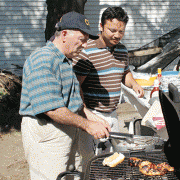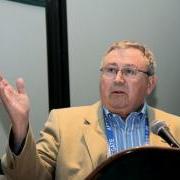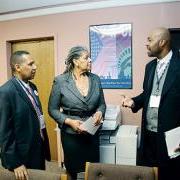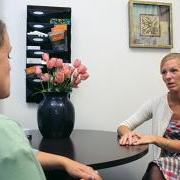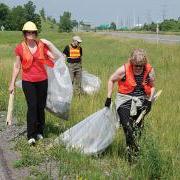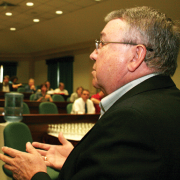|
Sabel Bong knows what it’s like to have nothing and be given a chance to have everything. That’s why Bong, a Canton UUP member, gives back. Bong, the child of Cambodian parents, was born in a Thailand refugee camp filled with Cambodians who fled their country to escape the Khmer Rouge, Cambodia’s brutal ruling party in the 1970s. His future uncertain, Bong was thrown a lifeline by caring strangers, thousands of miles away. An Ithaca Baptist church sponsored Bong’s family and brought them to America. Bong, a UAlbany graduate, never forgot the selfless gesture that changed every aspect of his life, and he’s been paying it forward ever since he was old enough to lend a helping hand. He volunteered with Big Brothers Big Sisters of the Capital Region in Albany as a UAlbany student in the 1990s. Realizing how much he enjoyed working with kids, he began donating his time to a new organization, Children of Our Community Open to Achievement, or COCOA House, in 2003. The Schenectady-based non-profit group offers homework help and snacks, and teaches computer and life skills to more than two dozen elementary school students from the city’s Hamilton Hill area. And it’s all free. Bong, who lives in the Canton area, has worked with COCOA House since his college days, cutting lawns, planting flowers and doing yard work. His then-girlfriend, Marvenia, who is now his wife, introduced him to the program, started by Marvenia’s sister, Rachel. His involvement progressed; recently, he stepped in as the organization’s executive director and drives to Schenectady—which is about a four-hour ride—as many as three weekends a month to take care of COCOA House business. He does it because he cares. “I want to give those kids as much opportunity as I was given coming to this country,” Bong said. “I want to open doors for them. I want to look them in the eye, shake hands firmly and know they can succeed. It’s about inspiration and hope, that they can do anything they set their minds to.” That’s a big reason Bong found himself behind a grill on a muggy Saturday afternoon in August, flipping burgers and serving up bowls of spicy Cambodian curry chicken and Jamaican jerk chicken to some of the 60 or so kids, volunteers and local politicians who came out for COCOA House’s community award ceremony and fundraiser. When he wasn’t grilling, he was running between the kitchen and a computer, from which he printed certificates of appreciation for COCOA House volunteers. And that doesn’t count the hours he spent before the event, obtaining a stage, booking entertainment and getting a city permit to close off roads near the house for the party. “It’s hectic but it’s fun,” he said. And well worth the effort for Bong, who has seen firsthand how tough it is for COCOA House kids, many of who come from low-income families and live in a neighborhood that has been plagued by crime and violence. COCOA House’s digs used to be a dilapidated den for crack users, he said. “I was tutoring last December and we asked students what they wanted for Christmas,” Bong said. “One of the students said that the only thing she wants is her dad back. One kid, he didn’t have enough money for a portable (PlayStation Portable) video game, so he took a piece of paper and drew a game and pretended to play that.” “It’s people like Sabel, who give back to their community and help make Schenectady a great city,” said Mayor Bryan Stratton, after being handed a certificate by Bong at the fundraiser. “COCOA House has made a tremendous impact on our community and it’s due to the dedication of people like Sabel.” And COCOA House continues to grow. Recently, a family whose son was killed by a gunshot in 1995 donated a nearby house to COCOA House. It will cost about $90,000 to renovate the house for the program’s use; Bong said the group’s directors are seeking donations and companies who will do the work for free or at little cost. “I feel honored to be here,” said Bong. “When I look in the eyes of those kids, I give them my very best. If it were anything less than that, I’d feel like I’d be letting them down.” — Michael Lisi |
Author Archives: United University Professions Admin
Miles of smiles: UMU member helps provide school supplies
|
There aren’t many smiles on Syracuse’s impoverished south side these days, but UUPer Dawn Leadley wore one as she supervised volunteers early on an August Saturday, hours before Mary Nelson’s annual Youth Day barbecue was set to begin. There would be lots of smiles that day. Leadley was one of more than 400 volunteers who grilled hot dogs, packed snow cones and handed out free school supplies for thousands of neighborhood students and parents who attended the yearly Saturday giveaway, held Aug. 21. This was her sixth year volunteering for Youth Day. “You hear testimonials from parents and teachers about the kids who register (for school supplies), that they barely have a shirt on or they have holes in their shoes, let alone their school supplies,” said Leadley, a member of the Upstate Medical University (UMU) Chapter. “This is a great cause.” More than 15,000 students in pre-kindergarten through college registered to receive backpacks, computers and other supplies donated by area businesses and organizations this year; that’s 6,000 more students than last year. The ninth-annual party included a parade, a barbecue, dancing, carnival games and more—all of it at no charge to participants. “I do whatever I can each year, including serving cotton candy and supervising the moonwalk (contest),” said Leadley, who works with Nelson at UMU and got involved after hearing about Youth Day. Over the years, Leadley has helped to secure donations for the event, and has handled everything from registration to handing out the supplies. Still, it’s not difficult for Leadley to see past the sticky, cotton-candy smiles and recognize the stark reality that is life for more than a few of these kids. “One year, an eight-year-old boy showed up alone to pre-register for (supplies),” said Leadley. “He had walked from the city’s north side to the south side because he couldn’t wake up his mother and he was afraid that he wouldn’t get his backpack.” Without the barbecue, many of these students would go to school without notebooks, pencils and backpacks. That’s one of the reasons why Leadley has made a point to stay involved, she said. “It’s such a nice event,” she said. — Michael Lisi |
June 2010

To the Point: PHEEIA’s down—but not out
|
It is obvious to me that one of the biggest reasons we were able to set aside the so-called Public Higher Education Empowerment and Innovation Act (PHEEIA) was because someone got involved. You. Thousands of you spoke out against the Act, calling, e-mailing and faxing legislators. From the outset, we spoke up against the elimination of SUNY’s governmental oversight and its accountability under existing state statutes. We made access and affordability statewide issues. SUNY supporters, many of them contacted through our Save SUNY website, www.savesuny.org, also took action and played an important role. That site and the UUP website yielded nearly 25,000 faxes and more than 4,500 online petition signatures. And despite Gov. David Paterson’s insistence that PHEEIA be part of the state’s 2010-11 budget, the legislators listened, even the two senators from Buffalo and Long Island who held out for weeks for PHEEIA’s approval. Finally, on Aug. 3, the state budget was adopted without the ill-conceived Act. The outcome could have been drastically different. PHEEIA had somehow become the last stumbling block to passing a very late state budget. Without your loud voices and UUP’s full-court press, legislators may have felt forced to give in. They felt forced in May, when they approved an emergency budget extender bill that included the governor’s plan to furlough 100,000 state workers—including UUPers—one day a week until the budget was passed. State business would have stopped without the extender bill. That’s when we stepped in and took care of business. UUP and other state unions immediately obtained a stay to stop the furloughs, which were blocked May 28 by federal Judge Lawrence Kahn. Another challenge met; another crisis averted. While the furloughs are history, PHEEIA isn’t. This nebulous proposal, which was pushed hard by SUNY, will be back at some point, you can be sure of that. Senate Democrats say they have a “framework” of a deal on PHEEIA with the Assembly, but no details have emerged since that Aug. 3 announcement. While we should feel satisfaction for a job well done, it’s not time to be patting each other on the back. We must be ready, at a moment’s notice, to forcefully speak out against PHEEIA, which would essentially corporatize SUNY by allowing campuses to raise tuition and enter into contracts and leases without state oversight. We must also be ready to combat PHEEIA rhetoric, like inaccuracies found in an August Buffalo News editorial blasting legislators for dropping PHEEIA from the budget. The editorial claims SUNY tuition increases were returned to the state in the past, and that PHEEIA would end “state sweeps” of tuition money into the general fund. That has never been the case; SUNY has always controlled tuition dollars. Here’s more reality: SUNY sustained a $152 million state aid cut in the new budget. The New York State Theatre Institute lost $1.6 million—more than half of what it got last year. More hiring freezes, job cuts, larger classes and fewer courses will undoubtedly be the outcome. Campuses have dealt with those issues over the past two years due to state budget cuts that account for more than 25 percent of SUNY’s operating budget. The time is now for SUNY to help cover shortfalls in SUNY’s state-slashed budget. I’ve said this before: UUP will hold the chancellor to her promise to use $147 million in reserves to help cover state cuts. We’d like to see SUNY offer even more financial help for our cash-strapped campuses and hospitals. More funding would add needed fuel to SUNY, one of the state’s most prolific economic engines. And it will allow campuses to continue to offer a quality, affordable education to students across New York, which, after all, is SUNY’s mission. Looking back, we can feel secure in knowing that we fought hard for what we believed in, and we made a difference. As we enter a new academic year, we will face our share of challenges. This union will step up and meet those challenges head-on. But we need you to take a stand. I hope and trust that you will join us as we face each crisis and strive to keep UUP strong. |
Capitol corner: PHEEIA absent in final state budget
|
In a year of unprecedented political and financial volatility in New York state, it’s inevitable that SUNY would be affected. But the University found itself squarely in the middle of the state budget battle over the summer, when the governor used the so-called Public Higher Education Empowerment and Innovation Act (PHEEIA) as a bargaining chip that for months blocked passage of the last component of a new state budget. UUP waged a fierce fight against PHEEIA—and it paid off. When the state Senate approved the final piece of the state budget Aug. 3—a revenue bill—PHEEIA was not a part of it. Sens. William Stachowski and Brian Foley, who represent districts near Buffalo Center and Stony Brook, respectively, surrendered in their collective effort to stall approval of the revenue bill unless it included PHEEIA. “In putting aside the enactment of the governor’s proposal to permit SUNY to unilaterally raise tuition and enter into public/private partnerships, the Legislature has preserved access and affordability while protecting SUNY’s core public mission,” said UUP President Phil Smith. “We thank them for their thoughtful and wise decision regarding an issue of critical importance to all New Yorkers.” But pushing PHEEIA aside was not easy. The union waged an aggressive multi-media campaign that included half-page ads in several major newspapers, including The New York Times and Newsday, as well as in nearly 150 weekly newspapers. The ad asked readers to visit savesuny.org, a website launched by UUP to promote public awareness of the dangers of state budget cuts and PHEEIA. The site encouraged visitors to sign an online petition and fax letters urging lawmakers to reject the SUNY budget cuts and SUNY flexibility proposal. That micro website and uupinfo.org yielded nearly 25,000 faxes and more than 4,500 online petition signatures. In addition, Smith wrote an opinion column presenting the case against PHEEIA that appeared in nearly a dozen newspapers. Six other daily newspapers printed a letter to the editor from Smith. The budget was more than two months late when the governor placed the PHEEIA legislation in his June 28 budget extender bill. The Legislature—faced with the choice of approving the extender bill or rejecting it and sparking a state government shutdown—put together and approved an alternative budget plan without PHEEIA. Their action removed the governor’s chief political weapon: the threat of a government shutdown. But the budget remained incomplete because of the Senate’s inability to pass the revenue bill. The stalemate continued as proponents of PHEEIA waged a desperate campaign to turn the tide in their favor. For example, when UUP member Edward Herman of Buffalo Center wrote an opinion column against PHEEIA that ran in the Buffalo News, proponents fired back with letters and columns attempting to undermine UUP’s position. But UUP’s message was getting through, as exemplified in an editorial in The New York Times. “Giving New York’s university system a few world-class campuses is a lofty idea. It just doesn’t belong in a hastily drawn compromise as part of a very late budget. The Legislature should drop the idea and finish the budget,” The Times wrote. While UUP succeeded in turning PHEEIA aside, the fight is not yet over. Even as the Senate voted to finalize the budget without PHEEIA, Senate Democratic Conference Leader John Sampson announced the “framework” of a deal on SUNY “empowerment” had been reached with the governor and the leadership in the state Assembly. Details of the deal had not been released as The Voice went to press. “We’re not exactly sure what this means,” Smith said. “We do know that we need to continue to be vigilant to protect SUNY as an institution of public higher education.” The details on SUNY budget cuts were clear, and gloomy. Facing an ultimatum from the governor to enact a new state budget, the Legislature approved a portion of the spending plan that trimmed SUNY’s budget by another $152 million, bringing the total reduction for the state-operated campuses to $562 million over a two-year period. Given the late passage of the budget, the full impact of this latest round of cuts had yet to unfold, but UUP members are bracing for more of what they’ve already seen: hiring freezes, job losses, fewer courses, larger class sizes and many more students looking to enroll at SUNY. The hurt has already hit System Administration, where the University’s decision to shut Nylink translates to the loss of 12 jobs in Albany. Nylink provides a variety of services to more than 500 libraries, including most of SUNY’s and all of CUNY’s libraries. SUNY claims declines in Nylink’s revenues as a result of a changing business environment led to its demise. “SUNY’s decision to shut down Nylink is very unfortunate,” said John Schumacher, UUP chapter president at System Administration. “Nylink was making real progress toward re-establishing the revenue needed.” The New York State Theatre Institute took a major hit—$1.6 million—more than half of its state support. With more than a dozen chapter members exploring early retirement, NYSTI Chapter President John Romeo predicts NYSTI will face a difficult road ahead. “NYSTI’s operation will be downsized, the amount of education and production will be downsized, and the administration will be severely hogtied as a result of the governor’s cuts,” Romeo said. Even before the budget gained approval, Stony Brook’s administration virtually closed its Southampton campus effective this fall. Thirty-three employees received non-renewal notices; 42 others were transferred to the main Stony Brook campus. Also on Long Island, about 200 part-time faculty at Farmingdale got served with non-renewals. Now is the time for SUNY to dip into its rainy day funds, Smith said. “This is more than just a passing shower—SUNY is reeling from a torrential downpour,” he said. “We must hold the chancellor to the promise she made during legislative budget hearings to apply $147 million from SUNY’s reserves to make up for state aid cuts.” — Donald Feldstein |
ESF UUPer lends an ear, gives her heart
|
For UUPer Heather Rice, it’s all about being there. It’s about listening, and providing support and comforting words to youths and teenagers struggling to accept their parents’ divorce, or who have dealt with a host of other traumas, such as being abused, bullied or lost in a whirlwind shuffle of foster homes. And sometimes, just being there can change a life. That’s why Rice, a licensed mental health counselor at the College of Environmental Science and Forestry, volunteers a few hours each week at Integrative Counseling Services in Oswego. There, she counsels adolescents and teens—many of who are referred by doctors, school counselors and the Oswego County Department of Social Services—that need someone to talk to and someone to listen, at little to no cost to their parents, grandparents or legal guardians. “I had a client who experienced a huge loss when someone close to her committed suicide,” Rice said. “As she was getting ready to leave our session, she put her arms on my arms, looked in my eyes and said, ‘I absolutely could not have made it through this without you.’ These are the times that I’m reminded why I do this.” Rice, who earned her master’s degree from Oswego, began donating time at Integrative a few years ago, first as a graduate student and later to build up clinical hours needed to get and maintain her counselor’s license. She stayed on as a volunteer because of a desire to provide mental health treatment to teens, something she doesn’t do in her job at ESF. “I guess if you had to characterize my role (at ESF), it would be assisting college students,” she said. “Students check in regularly and there is no mental health plan for them. At the agency, it allows me to keep my counseling skills and fulfills the need I have to provide mental health treatment.” With a husband and a family of her own, it’s not always easy to make time in her busy schedule to volunteer. But Rice is passionate about giving back to her community. That passion has made a huge difference in the lives of some of Rice’s clients. “A lot of times, I’m the only person the adolescent can open up to,” she said. “My relationship with them is unconditional.” — Michael Lisi |
UMU signed on to clean up
|
Some people adopt children. Others adopt pets. The Upstate Medical University Chapter of UUP has adopted a highway. Well, a one-mile stretch of it at least. A little over five years ago, the Upstate Chapter executive board discussed how they could give back to the community—in ways beyond their day-to-day duties as professionals in an academic medical center. Following the recommendation of a former chapter president, the board decided to adopt a stretch of highway along I-481 near Rock Cut Road in Syracuse. At least twice a year between April and October, the “I-481 Clean Up Krewe” takes to the street to bag trash that collects along their adopted highway. When the weather cooperates, the team cleans up more often. On average, eight UUPers lend a hand to each cleanup effort. UMU Chapter delegate Brian Tappen was among the first to get involved. He wanted to get outside and get his hands dirty, and adopting a highway seemed the perfect fit. “For me personally, it was a combination of things,” said Tappen, a statewide Executive Board member. “I believe in community service, and I wanted to work outside after a long night shift at the hospital.” Fellow UUPer Dawn Leadley believes being part of the I-481 Clean Up Krewe is a win-win situation. “Volunteerism provides rewards not only to individuals and communities, but to teams,” she said. “There is a unique bond that occurs when three or more people, covered with sweat and mud in the 90-degree sun, negotiate the best way to haul out discarded tires from a roadside ditch filled with ankle-deep water.” The Adopt-A-Highway program is run by the state Department of Transportation (DOT), which turned to volunteers in the 1980s when state budget cuts meant fewer resources for roadside beautification. In exchange for its help, the volunteer organization gets its name on a blue road sign announcing it as an Adopt-A-Highway sponsor. DOT provides trash bags, safety helmets and orange safety vests. Over the years, Tappen has added road safety cones to the collection, as well as more than two dozen “trash pickers”—thin wooden sticks screwed together to form a kind of tong—that he built and stenciled with “United University Professions” on one side and “Upstate Medical University” on the other, left. The safety equipment is housed at the chapter office. The most recent clean-up effort was June 19, and included UMU Chapter President Carol Braund, Bob Fluck, Leadley, Paul Stasior and Tappen. Members from other chapters are invited to join the clean-up effort. “I am acutely aware of how lucky I am to be a state employee and do not, for a moment, take that for granted,” Leadley said. “I appreciate that my employment is funded by taxpayers. Volunteering makes me feel like I am, in a way, giving back to those that allow me such wonderful professional and union-related opportunities.” — Karen L. Mattison |
UUP joins AFT in building bridges
|
NAACP President Ben Jealous summed up the situation in a simple, eloquent way. “If we’re going to put this country back to work, we have to pull this country back together,” he said. With that, more than 3,000 American Federation of Teachers members—including more than 70 UUPers—from across the country, erupted in applause for the young, charismatic speaker at AFT’s 81st convention in July. Jealous also earned applause after lashing out at the Tea Party movement and urging unionists to join the planned Oct. 2 “One Nation March” in Washington, D.C. Delegates also heard from AFT President Randi Weingarten, AFL-CIO President Richard Trumpka and Microsoft founder Bill Gates. The theme for the biennial event, held in Seattle, was “Building Bridges Together,” and UUP members took that to heart by attending general sessions, taking part in divisional meetings focused on higher education, and going out of their way to help make the convention run smoothly. Seven UUPers from six chapters volunteered to work at registration tables and serve as sergeants-at-arms. Tom Hoey of Albany, Josheila Crandall and Cheryl Hoyte of Brooklyn HSC, Nuala Drescher of Buffalo State, and Jeannie Galbraith of Stony Brook HSC worked at the registration tables, helping out UUP Secretary Eileen Landy, Dave Kreh of Cortland and Robin Nichols of Upstate Medical University. Janie Forrest-Glotzer of Oneonta and Artie Shertzer of Stony Brook served as sergeants-at-arms, aiding Frank Maraviglia of Environmental Science and Forestry, who usually does that job at AFT conventions. “Our members stepped up and did a great job, as acknowledged by AFT,” Landy said. Hoyte said she was excited about being at the conference and hoped to learn how other higher education AFT locals are dealing with some of the same issues facing UUP. “The theme of the convention is building the future and I hope people can come together and see the connection,” she said. “We are all one and we need to work together toward that goal.” UUPers also cast votes to re-elect Weingarten, AFT Secretary-Treasurer Antonia Cortese and AFT Executive Vice President Loretta Johnson. UUP President Phil Smith was re-elected as an AFT vice president, along with NYSUT President Dick Iannuzzi, and NYSUT officers Lee Cutler, Kathleen Donahue and Maria Neira. NYSUT Executive Vice President Andy Pallotta was elected to his first term as an AFT vice president. Smith, a featured speaker at the AFT Higher Education divisional meeting, discussed how SUNY and CUNY are reeling after being hit with more than $800 million in state aid cuts over the last two years. “It’s important for us in higher education to step up and fight back,” he told the more than 300 delegates at the meeting. Weingarten, in her State of the Union address to delegates, sent a strong message urging delegates to become active in their communities and reconnect the union with average working people. That connection has been disrupted by hard economic times that have caused unions to become under attack for protections they have won for their members. “What a sad commentary that these hard-won, noble achievements now are seen as things that separate us from our communities rather than connect us to them,” she said. “We must work to change this.” Delegates passed several higher ed-related resolutions, including one to push policymakers and higher ed agencies and organizations to consult academic faculty and staff when it comes to defining and accounting for student success. A new AFT website, WhatShouldCount.org, has the latest news about student success and accountability. Delegates also agreed to promote an AFT report titled “Promoting Racial and Ethnic Diversity in the Faculty: What Higher Education Unions Can Do.” — Michael Lisi |
April / May 2010

To the point: We’re fighting for SUNY’s future, your future
|
We knew it wasn’t going to be easy. But few expected that SUNY would be under attack on so many fronts, and that the battle would be brought right into our living rooms. That happened in May, when Gov. David Paterson—who has done more to harm education than any governor in state history—attempted in an emergency spending bill to impose a weekly one-day furlough on more than 100,000 unionized state workers to cut costs until a state budget is passed. We threw a monkey wrench into those works. UUP—along with Professional Staff Congress/CUNY, CSEA and PEF— won a May 11 federal temporary restraining order to block the furloughs. The governor had a May 26 court date to “show cause” why the furloughs shouldn’t be stopped. This issue, as well as the 2010-11 state budget, were still unresolved as The Voice went to press. Before moving forward with furloughs, Gov. Paterson threatened layoffs and called for a lag payroll. He insisted we forego contractual salary increases, and then gave huge raises to a number of his aides. He quickly rescinded their raises after news outlets got wind of the spending. If the governor wants to talk, we’ll listen. But any deal worth considering will go to members for ratification, since it constitutes reopening our contract. Our members—not the governor—will control this situation. SUNY, by the way, stood by quietly as the governor cut campus budgets and forced the furlough issue. SUNY’s Board of Trustees sat still in April, when Stony Brook closed its Southampton campus for “budgetary reasons. Inexplicably, SUNY found $3 million this year to operate The Levin Institute, an entity that lost its state funding last year. That doesn’t mean that SUNY’s leaders have been complacent. Far from it. Over the last few months, they kicked into high gear a campaign to press for approval of the Public Higher Education Empowerment and Innovation Act (PHEEIA), which would allow SUNY schools to raise tuition, and enter into contracts, leases, and other business ventures without state oversight. UUP opposes PHEEIA because we believe it is anti-union, will privatize SUNY, reduce access and erode educational quality. We have stepped up our resistance to PHEEIA. Our members have made hundreds of visits to legislators and sent thousands of e-mailed faxes urging them to dismiss the Act. We created our Save SUNY website (www.savesuny.org), a Facebook page and a Twitter account to protest PHEEIA and state budget cuts to SUNY. We also ran television, Internet and print campaigns against PHEEIA and Paterson’s cuts to SUNY, the state’s public hospitals and the New York State Theatre Institute. So here we are without a state spending plan, more than two months after the state’s April 1 budget deadline. Let’s use their delay to continue urging legislators to restore the $152 million in state aid cuts slated for SUNY. If those cuts go through, SUNY will have lost more than $562 million—or nearly 25 percent of its operating budget—over the last two years! Rest assured, no matter what happens, we will hold the chancellor to her recent promise to expend $147 million in SUNY reserves to help cover state aid cuts. Now more than ever, we need you, our members, to take a stand for SUNY. Tell students, parents, business owners and other unionized workers about our fight and what saving SUNY can mean to them and all New Yorkers. Visit your legislators and tell them to restore cuts to SUNY, turn away PHEEIA and to vote no on any proposals advanced by the governor to breach our hard-won contract. We negotiated that contract in good faith. We are expected to uphold our obligations under the contract and we will. The governor should do the same.
|


